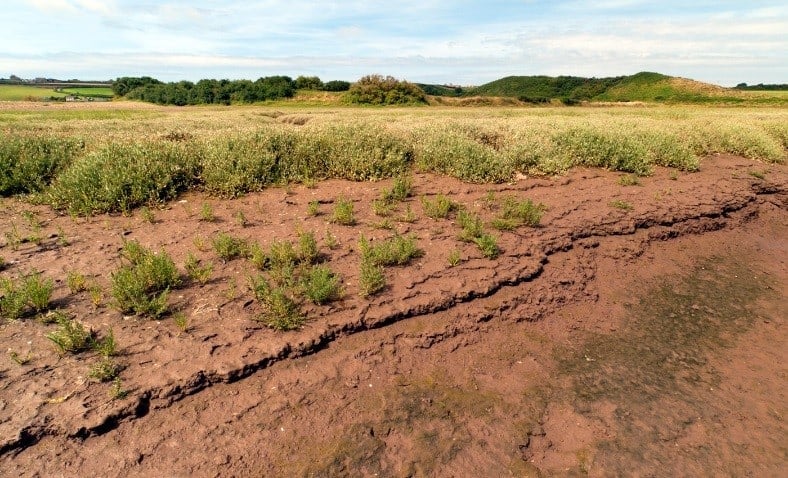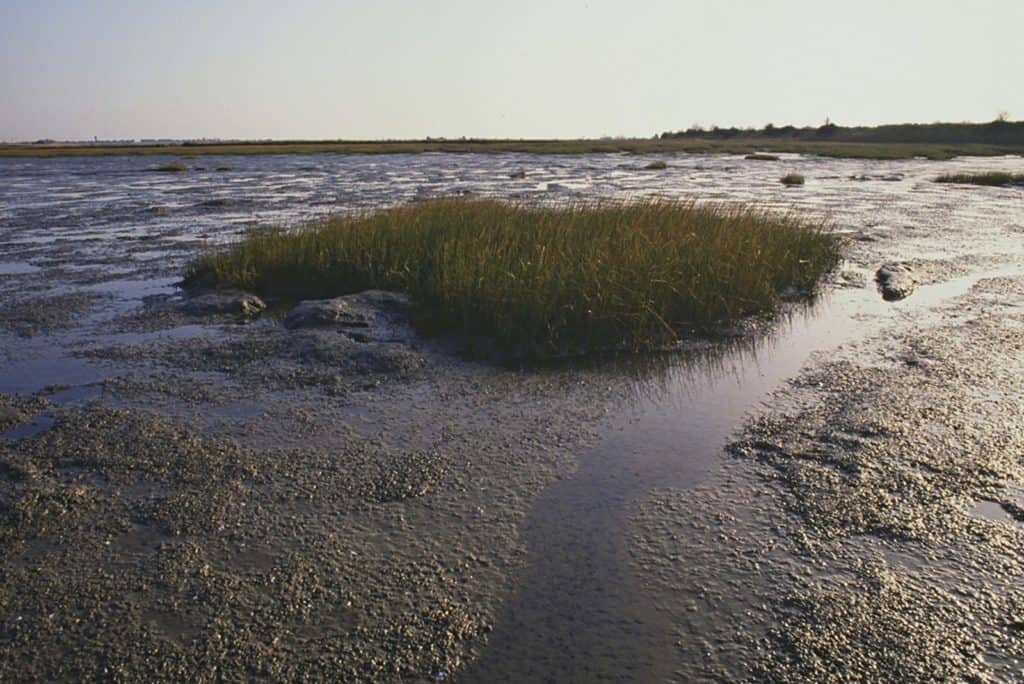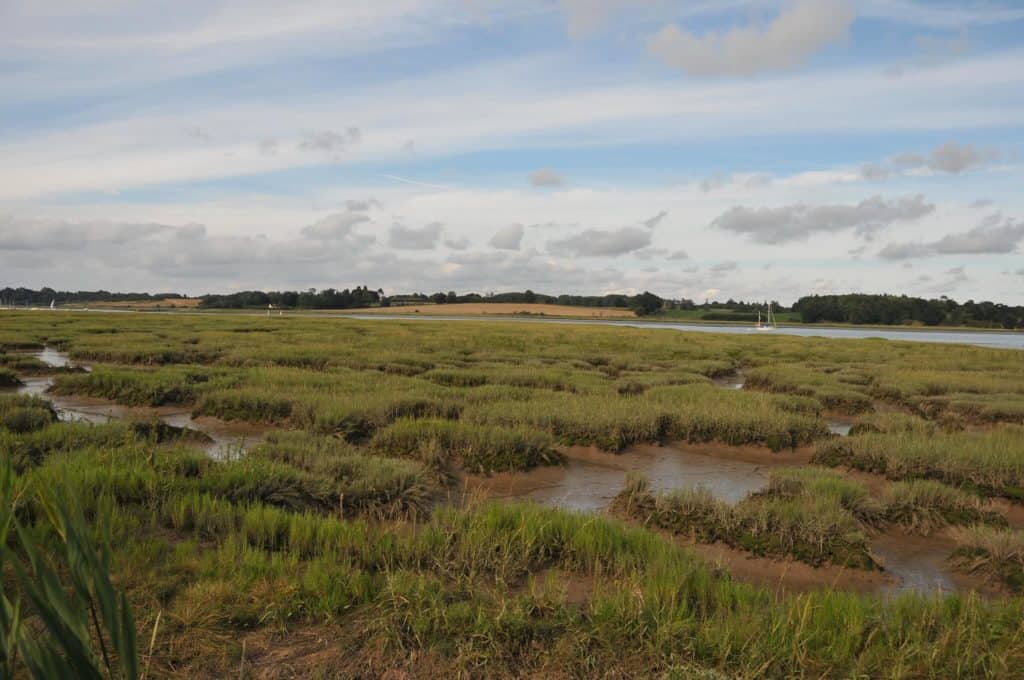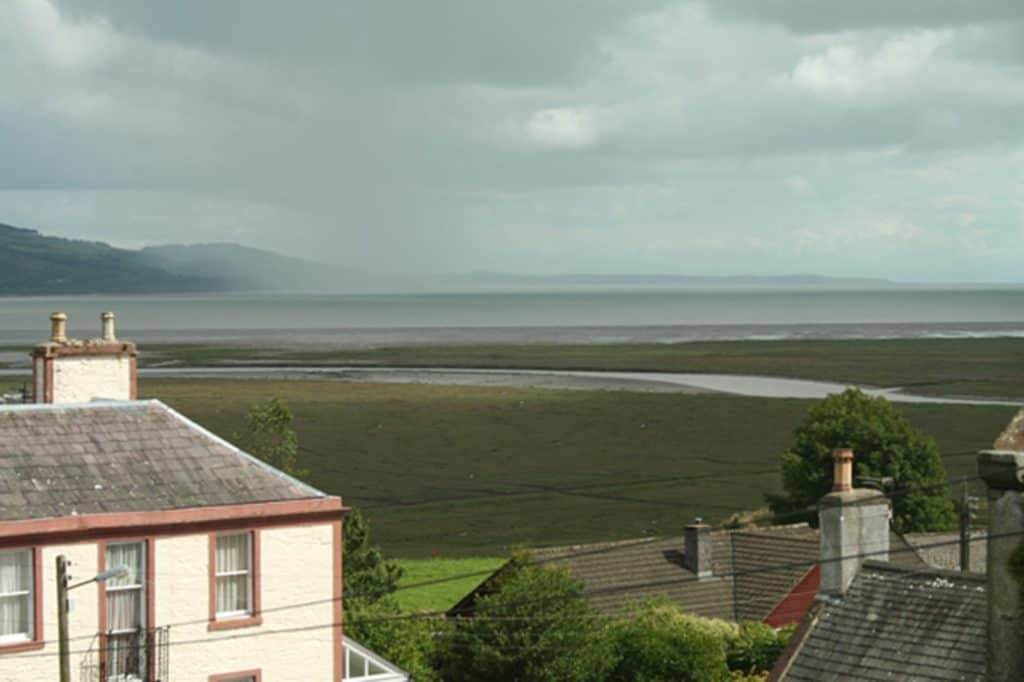What is this habitat like?
Primary succession can happen when bare mud on depositional coasts, bays, and estuaries is colonised by plants. Over time the mud builds up into a saltmarsh, raising the ground level above the height of the land above sea level. Succession in a saltmarsh is sometimes called a halosere.

Although succession takes place over time, different parts of a saltmarsh system can be taken to represent different stages of succession. If, for example, the saltmarsh is advancing towards the sea at 1 metre per year, this means that the land at 100 metres inland will have been out of the water for 100 years. Of course, this assumes that the saltmarsh is advancing at a constant rate, which may be contradicted by historical evidence.
Read more about the succession in saltmarshes, or read on for investigation questions.
What questions do biologists ask?
You can ask scientific questions about the saltmarsh environment. Here are some examples.

- How many different plant species can you see?
- What are the key features of the dominant plant species?
- What adaptations do the plants have to help them survive in this environment?

- What is the soil like here?
- How well does the soil here provide plants with what they need?
- How does the microclimate affect the growth of plants here?

- What changes do you predict will happen here in 50 years time?
- Would these changes be good or bad?
- If bad, what could be done about them?
What questions could you investigate by fieldwork?
Here are some examples. Each research question has been split into 2 or 3 sub-questions.
| Research question | Sub questions |
|---|---|
| Is primary succession happening at place x? | Does the distribution and abundance of vegetation change with height above sea level? How and why do abiotic factors change with distance from the sea shore? What evidence is there of different seral stages? |
| Does plant biodiversity increase as ecosystems go through succession? | Does the distribution and abundance of vegetation change with height above sea level? Is there a significant correlation between biodiversity and height above sea level? |
| What is the impact of human disturbance on the saltmarshes at place y? (e.g. tree felling, grazing by livestock, hard engineering) | Does the distribution and abundance of vegetation change vary between a disturbed and an undisturbed place (e.g. grazed vs ungrazed saltmarsh)? How and why do abiotic factors vary? What evidence is there for deflected succession? |
Synoptic links
A good investigation makes links between different parts of the Biology specification. Here are some possible synoptic links for investigations into saltmarshes.
| Synoptic link | Detail |
|---|---|
| Adaptation | r and K strategies – pioneers are r-selected while climax plants are more K-selected |
| Osmosis | Halophytic adaptations of many saltmarsh plants – sodium ion pump, surface area to volume ratio, salt secreting glands |
| Gas exchange | Adaptations for anoxic soil – arenchyma |
| Carbon cycle | Role of decomposers and detritivores in soil formation |
| Trophic levels and energy transfer | Role of chemoautotrophs in saltmarsh soils – sulphurating anaerobic bacteria Primary productivity (NPP is highest before the climax community) |
| Photosynthesis | Limiting factors such as soil nitrogen |
| Conservation | Management of succession for conservation, e.g. grazing |
Succession in saltmarshes
Where does the mud come from?
Saltmarshes develop on depositional coasts, bays, and estuaries where tidal movements are gentle and erosion is light. Clay particles carry a negative charge, so in freshwater they repel each other, and stay in suspension. But when freshwater mixes with seawater, as in an estuary for example, the negative charges are neutralised. In sheltered conditions, clays begin to bind together, or flocculate. By doing this they become larger and heavier, and eventually fall out of suspension and start to build up (processes known as sedimentation and accretion). These processes are continuous, meaning the height of the mud increases over time and the surface gradually experiences longer periods out of the water.
Stage 1: Migration
Migration must have occurred for anything at all to be present on the site. Plant seeds and spores are carried by the wind. Some of these land on the bare mud, where they can germinate and develop. If their seeds are sufficiently undisturbed, they will germinate and grow successfully. Once mud has built up sufficiently that it has risen above high tide level and is out of the water for 2 or 3 continuous days, any suitable plant seeds which are blown onto the mud may germinate and grow. Small pioneer plants will begin to colonise the surface of the mud.
Stage 2: Colonisation
Microscopic, filamentous cyanobacteria (blue–green algae) colonise the surface of the mud. They held to bind the mud surface together, trapping particles against their fronds. In summer fast growing ephemeral green algae like Enteromorpha spp. (gut weed) or Ulva spp. (sea lettuce) grow attached to small stones (or anything they can stick to) in the mud. These will also help to bind the surface of the mud together and trap particulate material against their fronds. But conditions are still harsh. The vegetation is described as ‘open’, as there is lots of open space between plants.
Stage 3: Establishment
More seeds and spores germinate and develop. Small halophytic (salt tolerant) pioneer plants such as glasswort (Salicornia spp.) and cord grass (Spartina spp.) can then colonise the surface of the mud.
The presence of these first plants on the developing saltmarsh will affect the physical conditions. Roots help consolidate the mud that has already built up by binding it together and carrying oxygen into it; and stems and leaves help trap more sediment. It has been estimated that Spartina can add 8-10 cm of mud a year to a salt marsh. In addition, the plants provide a source of food and places of refuge for animals. Decomposition of the plants over winter adds organic matter, nutrients and minerals to the muddy soil.
Stage 4: Competition
Over time, the mud becomes less stressful for plants, as death and decay of vegetation continues to add organic matter to the soil. The roots of pioneer plants will help consolidate the mud that has already built up by binding it together. As a result, the time that the mud is out of the sea water increases. The vegetation beomes ‘closed’, forming a continuous carpet over the ground and there is much less bare ground available.
With the physical environment improving over time, conditions become suitable for additional species to be present and plants such as sea purslane (Atriplex portulacoides), sea lavender (Limonium spp.), sea aster (Aster tripolium), plantain (Plantago spp.), scurvy grass (Cochlearia officinalis) and thrift (Armeria maritima) will take over from the pioneer species.
The number of species continues to increase as abiotic factors become more favourable. There are now a lot of species all wanting the same resources (water, light, carbon dioxide, oxygen, nutrients) from the same space at the same time. As there are not enough resources to go round, it produces competition. Competitive exclusion suggests that where different species are in strong competition one will prevail at the expense of the other.
Stage 5: Stabilisation
The species that have survived the competition stage will not be competing strongly with one another anymore as they all occupy different niches. Each species occupies its own niche, and therefore avoids having to compete strongly with other species. Vegetation is dominated by low-growing flowering plants such as scurvy grass (Cochlearia officinalis) and sea lavender (Limonium humile). Few new species appear at this stage.
Stage 6: Climax
Shading by taller vegetation means that woody species outcompete species from earlier seral stages, and so the species diversity is lower. The climax vegetation of saltmarsh succession is deceiduous woodland. No new species are added and the community remains the same over long periods of time (theoretically forever). The vegetation is said to be in equilibrium with the environment; a true state of balance has been achieved. The type of climax vegetation present is determined by the climate of the area, wind speeds and direction, animal grazing, pH, temperature and many other factors.

Secondary and Further Education Courses
Set your students up for success with our secondary school trips and courses. Offering excellent first hand experiences for your students, all linked to the curriculum.
Group Leader and Teacher Training
Centre-based and digital courses for teachers
Experiences for Young People
Do you enjoy the natural world and being outdoors? Opportunities for Young People aged 16-25.
